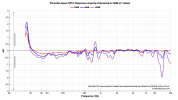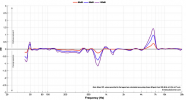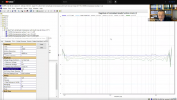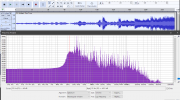I have watched that video in the past. Those short-time compression effects were for little BT drivers, not kind of speakers we are talking about.
Just because Prof. Klippel used a small sample speaker, short-term compression measurements are still interesting for every speaker

For a professional PA speaker, long-term compression is certainly important, as nobody wants a PA speaker that completely changes its sound characteristics after an hour.
For home speakers, short-term compression is more interesting, as almost immediate changes in frequency response at high SPL are indicated. This provides information about the design, quality of the drivers used, used limiter and DSP behavior for active speaker at high SPL and indicating possible unintended, disturbing changes in sound at high SPL.
In the case of the PS Audio FR10, short-term compression is not perfect, but relatively inconspicuous. The dip at 14kHz will probably not be noticed by anyone:

On the other hand, there are speakers that show pronounced short-term "negative compression"***, for example around 6kHz, which could be disturbing during high SPL:

Further, microphone in those tests is kept at 1 or 2 cm from the driver, which excludes the room effects. None of this applies to Erin's tests.
As long as the room does not exhibit resonances, room reflections are not a problem at all (when the results are normalized to the reference measurement), as the position of the DUT and microphone are not changed during the measurements.
Take another look at the video by Prof. Klippel; he explicitly
addresses this issue here. In the video, he chooses the smallest possible distance to the DUT to keep the Signal-to-Noise Ratio as small as possible.
Erin shows anti-compression where levels at some frequencies increase more than it should. Nothing in the world of "compression" explains such things.
Each resonance of the speaker or driver is able to do that. Instead of compression, one can obtain "amplification", "enhancement" or "negative compression"*** whatever one want to call it.
An example of this was given in
post#239 - driver resonance fs. "Negative compression" can occur around the resonance frequency of the driver or fc of the speaker.
In the video, Prof. Klippel briefly
touches upon this here, or you can find the explanation in the "Loudspeaker Nonlinearities – Causes, Parameters, Symptoms" paper by Klippel:

But as mentioned, surround resonance, driver cone eigenmodes, driver frame resonance,... are all possible causes of "negative compression" in compression measurements.
Further, that kind of graph with such high resolution is not shown. Instead, what Dr. Klippel showed was the same graphs I did, not a differential focusing down to the smallest differences.
Amir, as already mentioned, the visualization of the compression measurements normalized to a reference measurement is common and facilitates the evaluation and identification of interesting frequency ranges.
Prof. Klippel also shows this type of graph
in the video. The DUT also shows "negative compression" at two points in the frequency range in the Klippel measurement, as mentioned above, this is not unusual.

Please watch the whole video again, your memory seems to mislead you on some points.
*** Compression is per definition is positive, so amplification is negative. A more intuitive approach is probably the inverse representation (compression as negative value). Ultimately, it doesn't matter as long as it is clearly indicated what is meant.





